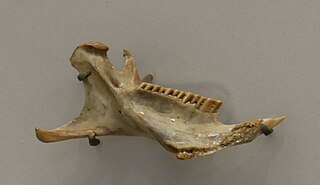
Eulipotyphla is an order of mammals suggested by molecular methods of phylogenetic reconstruction, which includes the laurasiatherian members of the now-invalid polyphyletic order Lipotyphla, but not the afrotherian members.

Solenodons are venomous, nocturnal, burrowing, insectivorous mammals belonging to the family Solenodontidae. The two living solenodon species are the Cuban solenodon and the Hispaniolan solenodon. Threats to both species include habitat destruction and predation by non-native cats, dogs, and mongooses, introduced by humans to the solenodons' home islands to control snakes and rodents.

The Puerto Rican nesophontes, or Puerto Rican shrew, is an extinct eulipotyphlan endemic to Puerto Rico.

Megalomys luciae, also known as the Saint Lucia pilorie or Saint Lucia giant rice-rat, as well as several variant spellings, is an extinct rodent that lived on the island of Saint Lucia in the eastern Caribbean.

Nesophontes, sometimes called West Indies shrews, is the sole genus of the extinct, monotypic mammal family Nesophontidae in the order Eulipotyphla. These animals were small insectivores, about 5 to 15 cm long, with a long slender snout and head and a long tail. They were endemic to the Greater Antilles, in Cuba, Hispaniola, Puerto Rico, the United States Virgin Islands, and the Cayman Islands.

The Hispaniolan solenodon, also known as the agouta, is a small, furry, shrew-like mammal endemic to the Caribbean island of Hispaniola. Like other solenodons, it is a venomous, insect-eating animal that lives in burrows and is active at night. It is an elusive animal and was only first described in 1833; its numbers are stable in protected forests but it remains the focus of conservation efforts.
The Hispaniolan edible rat is a recently extinct species of rodent in the family Echimyidae. It is the only species in the genus Brotomys. It was endemic to the island of Hispaniola in the Caribbean, in what is today the Dominican Republic and Haiti. Its natural habitat was subtropical or tropical moist lowland forests.
The imposter hutia is an extinct species of rodent in the hutia subfamily (Capromyinae). It is the only species in the genus Hexolobodon and tribe Hexolobodontini. It was found only on the Caribbean island of Hispaniola, and went extinct sometime after European colonization in the 1500s.

The Puerto Rican hutia is an extinct species of rodent in the family Capromyidae. It was found on Hispaniola and Gonâve Island; it was introduced to the Virgin Islands and Puerto Rico.
The Atalaye nesophontes is an extinct species of mammal in the family Nesophontidae. It was endemic to Hispaniola in the Caribbean, and is only known from fossil deposits.

The western Cuban nesophontes is an extinct species of mammal in the family Nesophontidae. It was found on Cuba and Hispaniola. It was recently discovered to include three previously thought species: N. submicrus, N. longirostris, and N. superstes.
The Haitian nesophontes is an extinct species of mammal in the family Nesophontidae. It was endemic to Hispaniola in the Caribbean. The species was often found in hot and humid swamps, such as the Mires húmedos swamp of Northern Dominica.
Marcano's solenodon is an extinct species of mammal in the family Solenodontidae known only from skeletal remains found on the island of Hispaniola.
The Caribbean bioregion is a biogeographic region that includes the islands of the Caribbean Sea and nearby Atlantic islands, which share a fauna, flora and mycobiota distinct from surrounding bioregions.

The greater Cuban nesophontes is an extinct species of eulipotyphlan that was native to Cuba. It is thought that the introduction of rats lead to its demise.
A unique and diverse albeit phylogenetically restricted mammal fauna is known from the Caribbean region. The region—specifically, all islands in the Caribbean Sea and the Bahamas, Turks and Caicos Islands, and Barbados, which are not in the Caribbean Sea but biogeographically belong to the same Caribbean bioregion—has been home to several families found nowhere else, but much of this diversity is now extinct.







